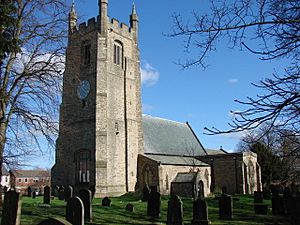Church of St Edmund, Sedgefield facts for kids
Quick facts for kids Church of St Edmund, Sedgefield |
|
|---|---|
 |
|
| Location | Cross Hill, Sedgefield, County Durham, TS21 3AT |
| Country | England |
| Denomination | Church of England |
| Churchmanship | Central/ Low Church |
| History | |
| Status | Active |
| Dedication | Edmund of Abingdon |
| Architecture | |
| Functional status | Parish church |
| Heritage designation | Grade I listed |
| Designated | 9 January 1968 |
| Years built | 1246 to 1256 |
| Specifications | |
| Spire height | 90 feet (27 m) |
| Administration | |
| Parish | Upper Skerne |
| Archdeaconry | Archdeaconry of Durham |
| Diocese | Diocese of Durham |
The Church of St Edmund is a special church in Sedgefield, County Durham, England. It's part of the Church of England. This church is very old, built in the 1200s! It's also a Grade I listed building, which means it's super important and protected because of its history and beauty.
Contents
History of the Church
Early Beginnings
The area around Sedgefield became a church 'parish' (a special church district) a very long time ago, between the years 900 and 915. A bishop named Cutheard of Lindisfarne helped set this up. The very first church here was probably made of wood. Later, the Normans built a stronger church using stone.
Building the Current Church
The church you see today was built between 1246 and 1256. It is named after Edmund of Abingdon. He was a very important church leader, an Archbishop of Canterbury, who passed away in 1240. This was just a few years before the church was built.
Over the centuries, more parts were added to the church. Around 1290, side sections called transepts and a special area for the altar, called a chancel, were built. About 200 years later, around 1490, a tall tower was added. In the 1800s, a porch was built at the entrance. Finally, in 1913, a vestry (a room for clergy) and a space for the organ were added.
On January 9, 1968, the Church of St Edmund was officially named a Grade I listed building. This means it's one of the most important historic buildings in England.
The Church Today
Today, the Church of St Edmund is still an active church. It is part of a group of churches called the Benefice of Upper Skerne. This group belongs to the Archdeaconry of Durham and the Diocese of Durham. The church follows a 'Central' style of worship within the Church of England.
Important People from the Church
- George Howe was the Rector (a type of priest) of this church from 1985 to 1991. He later became a senior church leader called the Archdeacon of Westmorland and Furness.

